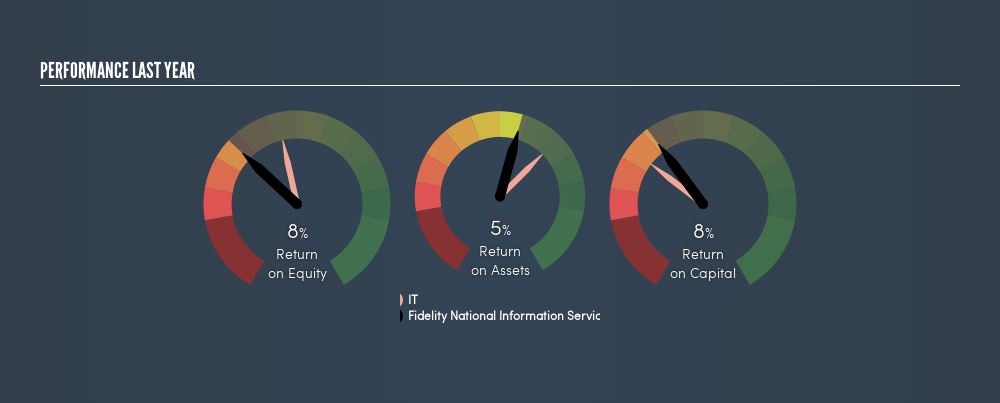- United States
- /
- Diversified Financial
- /
- NYSE:FIS
Why Fidelity National Information Services, Inc.’s (NYSE:FIS) Return On Capital Employed Looks Uninspiring

Want to participate in a short research study? Help shape the future of investing tools and you could win a $250 gift card!
Today we'll look at Fidelity National Information Services, Inc. (NYSE:FIS) and reflect on its potential as an investment. Specifically, we're going to calculate its Return On Capital Employed (ROCE), in the hopes of getting some insight into the business.
First up, we'll look at what ROCE is and how we calculate it. Then we'll compare its ROCE to similar companies. Finally, we'll look at how its current liabilities affect its ROCE.
Understanding Return On Capital Employed (ROCE)
ROCE measures the 'return' (pre-tax profit) a company generates from capital employed in its business. All else being equal, a better business will have a higher ROCE. In brief, it is a useful tool, but it is not without drawbacks. Renowned investment researcher Michael Mauboussin has suggested that a high ROCE can indicate that 'one dollar invested in the company generates value of more than one dollar'.
So, How Do We Calculate ROCE?
The formula for calculating the return on capital employed is:
Return on Capital Employed = Earnings Before Interest and Tax (EBIT) ÷ (Total Assets - Current Liabilities)
Or for Fidelity National Information Services:
0.076 = US$1.6b ÷ (US$24b - US$3.5b) (Based on the trailing twelve months to March 2019.)
So, Fidelity National Information Services has an ROCE of 7.6%.
See our latest analysis for Fidelity National Information Services
Does Fidelity National Information Services Have A Good ROCE?
ROCE is commonly used for comparing the performance of similar businesses. Using our data, Fidelity National Information Services's ROCE appears to be significantly below the 11% average in the IT industry. This performance could be negative if sustained, as it suggests the business may underperform its industry. Setting aside the industry comparison for now, Fidelity National Information Services's ROCE is mediocre in absolute terms, considering the risk of investing in stocks versus the safety of a bank account. Investors may wish to consider higher-performing investments.
Our data shows that Fidelity National Information Services currently has an ROCE of 7.6%, compared to its ROCE of 5.7% 3 years ago. This makes us think about whether the company has been reinvesting shrewdly.

Remember that this metric is backwards looking - it shows what has happened in the past, and does not accurately predict the future. ROCE can be deceptive for cyclical businesses, as returns can look incredible in boom times, and terribly low in downturns. ROCE is only a point-in-time measure. What happens in the future is pretty important for investors, so we have prepared a freereport on analyst forecasts for Fidelity National Information Services.
What Are Current Liabilities, And How Do They Affect Fidelity National Information Services's ROCE?
Current liabilities are short term bills and invoices that need to be paid in 12 months or less. Due to the way the ROCE equation works, having large bills due in the near term can make it look as though a company has less capital employed, and thus a higher ROCE than usual. To counteract this, we check if a company has high current liabilities, relative to its total assets.
Fidelity National Information Services has total assets of US$24b and current liabilities of US$3.5b. As a result, its current liabilities are equal to approximately 15% of its total assets. This very reasonable level of current liabilities would not boost the ROCE by much.
The Bottom Line On Fidelity National Information Services's ROCE
If Fidelity National Information Services continues to earn an uninspiring ROCE, there may be better places to invest. Of course, you might find a fantastic investment by looking at a few good candidates. So take a peek at this freelist of companies with modest (or no) debt, trading on a P/E below 20.
If you like to buy stocks alongside management, then you might just love this freelist of companies. (Hint: insiders have been buying them).
We aim to bring you long-term focused research analysis driven by fundamental data. Note that our analysis may not factor in the latest price-sensitive company announcements or qualitative material.
If you spot an error that warrants correction, please contact the editor at editorial-team@simplywallst.com. This article by Simply Wall St is general in nature. It does not constitute a recommendation to buy or sell any stock, and does not take account of your objectives, or your financial situation. Simply Wall St has no position in the stocks mentioned. Thank you for reading.
About NYSE:FIS
Fidelity National Information Services
Fidelity National Information Services, Inc.
Solid track record with reasonable growth potential.
Similar Companies
Market Insights
Community Narratives





